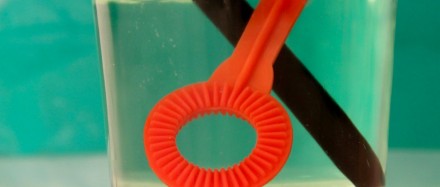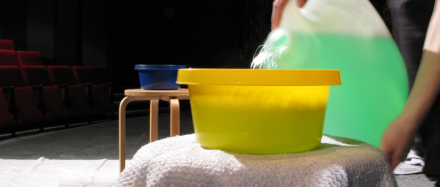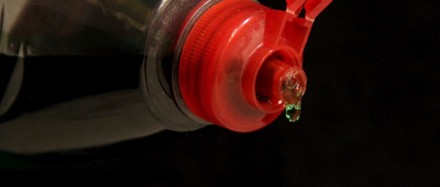Glycerol in soap liquid
Glycerol makes the soap bubbles more flexible and increase their life time.

Soap bubbles last for ever. Unless the water in the bubble evaporates.
Water in soap bubbles evaporates over time making the soap film thinner and thinner. Gravity is pulling most of the water downwards to the bottom of the bubble, and for this reason the soap film becomes thinner in the top part of the bubble than in the lower part. When the top film has become really thin, further evaporation of water from the top will finally break the soap film.
The bubbles will generally have a shorter lifetime in dry air, because the evaporation is higher in dry air than in air with high humidity. It is therefore a good idea to find a place with high humidity to make soap bubbles. The bath room is perfect right after a shower.

Glycerol makes the soap bubbles more flexible and increase their life time.
To decrease the evaporation of water from the bubbles one can use the trick of adding some glycerine to the soap-water mixture.
If you want to make soap bubbles that can last for hours or days, you will have to further decrease the evaporation. This can be done by storing the bubble in a closed room with very high humidity. The easiest thing is to put the bubble in a jar on a ring of wire. Fill some soap bubble mixture in the bottom of the jar and make sure to wet the wire and the sides of the jar before making the bubble. When the bubble is made, the jar should be firmly closed. Water from every surface in the jar will now evaporate and the humidity will quickly increase until the air is saturated with vapour. After saturation the evaporation will almost stop, and the bubble will be able to have a long life in the jar. Using our soap bubbles mixtures we have had bubbles lasting for a week in an ordinary jar, but others have had bubbles lasting for much longer. It is said that the soap bubble enthusiast Eiffel Plasterer succeeded in having a bubble lasting for more than a year! To make the bubbles last so long a special recipe is needed, but Eiffel Plasterers bubble mixture for long lasting bubbles unfortunately was always kept a secret. A flat soap film will not break as easily as a curved. The famous physicist James Dewar kept a soap film disk with a diameter of 19 cm for over three years! The recipe Dewar used can be found in: Dewar, Lady (ed.) (1927) Collected papers of Sir James Dewar, Cambridge, 2. volume.
In the end even the oldest bubble will break. And when it breaks it will be torn apart. The breakage of the bubble will start at a point from where the soap film will retract until all the remaining film meets at a point on the opposite side of the bubble than the breaking point. From here the soap water will be thrown further away from the breaking point. The process of breaking a soap bubble can be seen in slow motion if the process is recorded with a fast frame camera.
Alternatively, long lasting soap bubbles can be made by lowering the temperature of the bubbles. High temperatures will make the water in the soap bubbles evaporate faster. Therefore the bubbles will generally have a shorter lifetime at higher temperatures. Many people thinks of making soap bubbles as a summer activity, but a hot summer day can be a problem for the lifetime of the bubbles. The dependence of the bubble lifetime on temperature becomes very obvious if one tries to put a soap bubble into a preheated oven.
As a soap film is mostly composed by water it can of cause be frozen. This can be used as a strategy for making long lasting bubbles. It is very interesting to make soap bubbles in extreme cold weather, because the bubbles can freeze while they are falling through the air. If you are lucky the bubbles will land on the ground without breaking.
You can still manage to freeze a soap bubble even if you do not live north of the polar circle. Make a small holder for your bubble from a wire and dib it into a bubble mixture. Now blow a bubble on the holder and place it carefully in a freezer. After a minute the bubble will be frozen. A frozen bubble can last for a long time. As long as it is kept below 0 degrees Celsius, the evaporation from it will almost be stopped and the bubble will not break. But if you remove it from the freezer it will melt and in this process it will almost certainly break.
You can make a hole in the frozen bubbles with your finger without breaking the whole bubble. You can also grab the frozen bubble with your hands and felt it when it immediately melts.

The best recipes for mixtures for small and large soap bubbles that last longer

Glycerol makes the soap bubbles more flexible and increase their life time.

No bubbles without soap. But what is it about the soap that makes the bubbles?